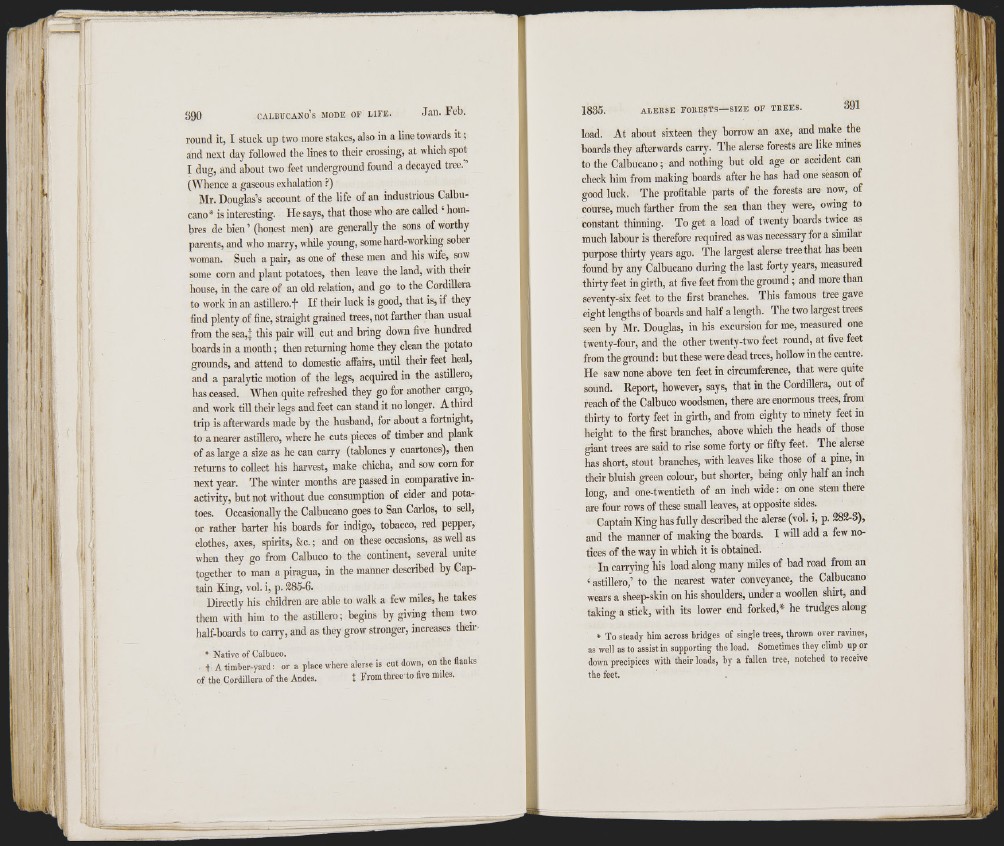
: i'
.1
I
■ítrifi
■ i l !
ii -1
7 ,
)
i l : i ]
ll!,
i!i7
ri .|i i
890 CALBUCANO’S MODE OF L IFE . Jan. Feb.
round it, I stuck up two more stakes, also in a line towards i t ;
and next day followed the lines to their crossing, at wliicli spot
I dug, and about two feet underground found a decayed tree.”
(Whence a gaseous exhalation ?)
Mr. Douglas’s account of the life of an industrious Calbu-
cano* is interesting. He says, that those who are called ‘ hom-
hres de bien ’ (honest men) are generally the sons of worthy
parents, and who marry, while young, some hard-working sober
woman. Such a pair, as one of these men and his wife, sow
some corn and plant potatoes, then leave the land, with tlieir
house, in the care of an old relation, and go to the Cordillera
to work in an astillero.-J* I f tlieir luck is good, that is, if they
find plenty of fine, straight grained trees, not farther tban usual
from the sea,] this pair wiU cut and bring down five hundred
boards in a month; then returning home they clean the potato
grounds, and attend to domestic affairs, until their feet heal,
and a paralytic motion of the legs, acquired in the astiUero,
has ceased. When quite refreshed they go for another cargo,
and work till their legs and feet can stand it no longer. A third
trip is afterwards made by the husband, for about a fortnight,
to a nearer astillero, where he cuts pieces of timber and plank
of as large a size as he can carry (tablones y cuartones), then
returns to coUect his harvest, make chicha, and sow corn for
next year. The winter months are passed in comparative inactivity,
hut not without due consumption of cider and potatoes.
Occasionally the Calbucano goes to San Carlos, to sell,
or rather barter his boards for indigo, tobacco, red pepper,
clothes, axes, spirits, &c.; and on these occasions, as well as
when they go from Calbuco to the continent, several unite
together to man a piragua, in the manner described by Captain
King, vol. i, p. 285-6.
Directly his children are able to walk a few miles, he takes
them with him to the astillero; begins by giving them two
half-boards to carry, and as they grow stronger, increases their
• Native of Calbuco.
t A timber-yard; or a place where alerse is cut down, on the flanks
of the Cordillera of the Andes. t trom three to five miles.
1835. ALEESE FORESTS— SIZE OF TREES. 391
load. At ahout sixteen they borrow an axe, and make the
boards they afterwards carry. The alerse forests are like mines
to the Calbucano; and nothing but old age or accident can
check him from making boards after he has had one season of
good luck. The profitable parts of the forests are now, of
course, much farther from the sea than they were, owing to
constant thinning. To get a load of twenty boards twice as
much labour is therefore required as was necessary for a similar
purpose thirty years ago. The largest alerse tree that has been
found by any Calbucano during the last forty years, measured
thirty feet in girth, at five feet from the ground; and more than
seventy-six feet to the first branches. This famous tree gave
eight lengths of boards and half a length. The two largest trees
seen by Mr. Douglas, in his excursion for me, measured one
twenty-four, and the other twenty-two feet round, at five feet
from the ground: but these were dead trees, hoUow in the centre.
He saw none above ten feet in circumference, that were quite
sound. Report, however, says, that in the Cordillera, out of
reach of the Calbuco woodsmen, there are enormous trees, from
thirty to forty feet in girth, and from eighty to ninety feet in
height to the first branches, above which the heads of those
giant trees are said to rise some forty or fifty feet. The alerse
has short, stout branches, with leaves like those of a pine, in
their bluish green colour, but shorter, being only half an inch
long, and one-twentieth of an inch wide: on one stem there
are four rows of these small leaves, at opposite sides.
Captain King has fully described the alerse (vol. i, p. 282-3),
and the manner of making the boards. I will add a few notices
of the way in which it is obtained.
In carrying his load along many miles of had road from an
‘ astillero,’ to the nearest water conveyance, the Calbucano
weai-s a sheep-skin on his shoulders, under a woollen shirt, and
taking a stick, with its lower end forked,* he trudges along
* To steady him across bridges of single trees, thrown over ravines,
as well as to assist in supporting the load. Sometimes they climb up or
down precipices with their loads, hy a fallen tree, notched to receive
the feet.